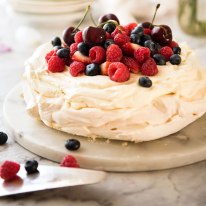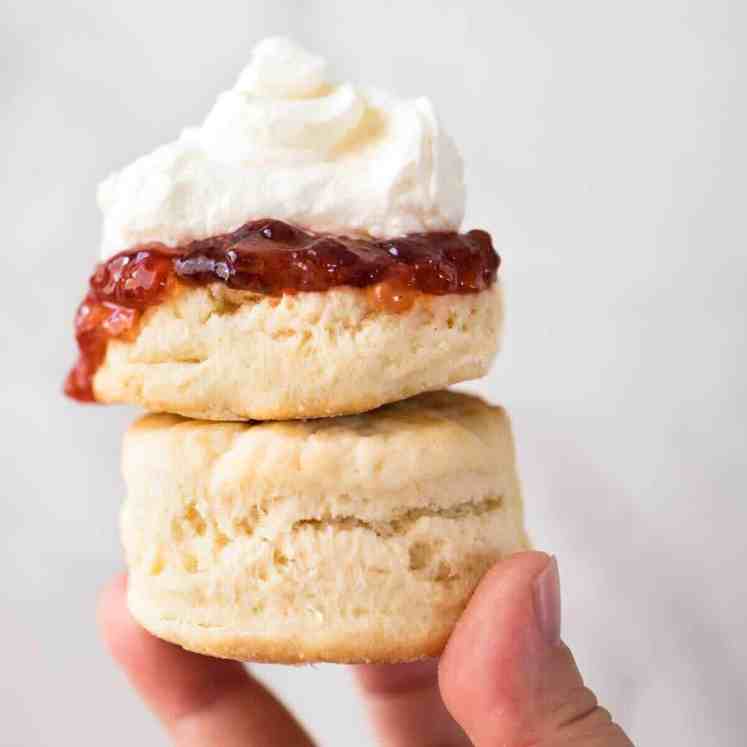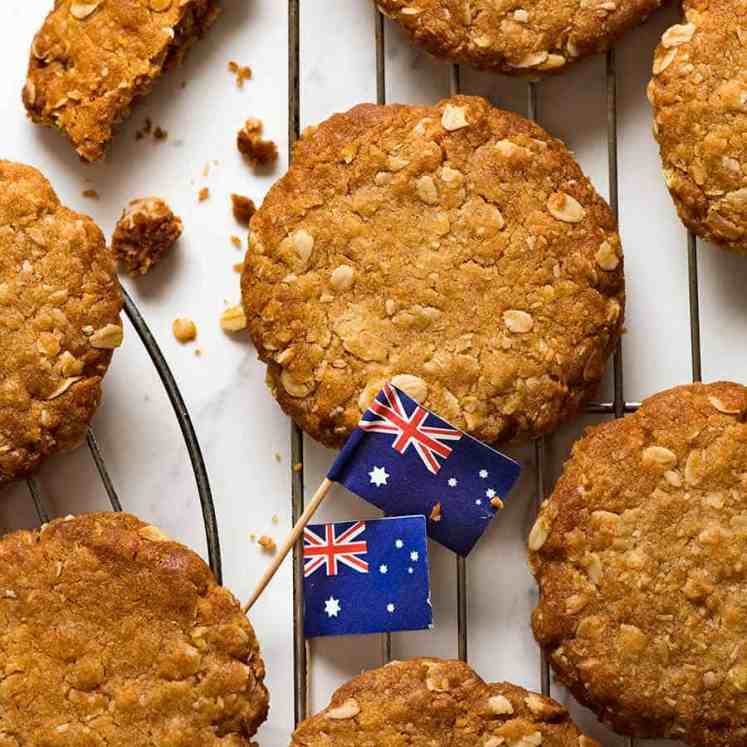The great Aussie Pavlova! With a how-to video and easy tips that make all the difference, you’ll nail this classic Pavlova recipe every single time. With a delicate meringue crust and soft marshmallow insides, top with cream and fruit for a pav that will steal the show at any gathering!
Next time, try Mini Pavs. They’re adorable!

Pavlova
There is no greater summer dessert than the great Aussie Pav!
Pavlova is one of those desserts that is notoriously easy yet notoriously difficult. I think many people are scared to make it. Others have lamented that you should just accept that it will come out of the oven quite cracked.
Though I’m going to be sharing my tips for a perfect near-flawless pav (including a few you may have never heard of before!), first up, let me be clear about one thing – it does not matter if it cracks!! Even if it cracks severely.
Just do your best to piece it back together, using cream as a glue and to hide the worst cracks. It only needs to hold together for you to place it on the table, for everyone to ooh and ah over it, for you to have your moment of glory.
The minute it gets cut to serve it up, it doesn’t matter. Even a perfect pav looks like a mess once it starts being served!
But as it so happens, if you follow my tips, I’m confident you’ll have a crack-less near-flawless Pav… 😉
With the recipe video and my secret tips, this Pavlova recipe is easy to follow and you’ll nail it every single time!

Tips for a perfect pavlova
I’ve seen many “no-fail pavlova” tip lists, but I’ve never seen a list with all of these, mainly because some of them are my own, discovered after many trial and errors!
1. Measure the egg whites by volume. This is a big tip! “4 egg whites” can range from anywhere between 100 – 180ml (3 – 6oz) depending on the size of the eggs + how much egg white you manage to get out of each egg. The amount of egg whites used is key to a successful Pav!
2. Use fresh store bought eggs. Not eggs that have been hiding in the back of your fridge for weeks!
Got your own chickens? I’m jealous! BUT, don’t use freshly laid eggs for pavlova as they take longer to fluff up. Use eggs that are circa 5 days+ old. Store bought eggs are a safe bet. 🙂
3. Separate the eggs while fridge cold. Trust me, it’s so much easier than when they’re at room temperature. PS If you’re new to separating yolks from whites, just crack the eggs into your hand and let the whites slide through between your fingers. Jiggle your hand slightly to get all the whites off the yolk, and you’ll be left with just the yolk sitting in your fingers.
4. Not even a drop of yolk is allowed! Even a bit of yolk can ruin the whole batch i.e. it won’t fluff up. So if you accidentally get yolk in your whites, you can try scooping it out using a shell (also good tip for picking out shell bits) but if you think there’s any chance it has tainted the rest of the whites, start again. It isn’t worth the risk!
5. Bring egg whites to room temperature. They fluff up much better. So separate while cold, then bring to room temperature.
6. Make sure your bowls and whisk are clean and dry. Grease and water can stop whites from fluffing.
7. Use an inverted cake pan. For shaping (saves you drawing a circle on paper) and also ease of transferring the Pav to a platter. There is nothing sadder than pulling a perfect Pav out of the oven, only to have it crack when transferring it to the serving platter!
Tips continued below photo….you didn’t think I was done, did you? 😉

8. WEATHER WARNING!!! Heat and humidity. As it happens, Pav is a summer dessert but it is not conducive to being made in hot humid weather. It can cause the Pav to collapse during or after baking. I don’t know the exact temperatures and humidity % cut off points and had a number of epic failures before I figure out tips #9 – #13. Using the tips below, the Pav in the photos were made last week during a heat wave when it was 33C/91F and humidity was 65 – 75%. So if it is hot and humid where you are, do not skip #8 onwards, they were created especially for the Aussie summer!!!
9. Bigger is better….except in summer 😎 I know, I know. You want to do a giant pav. But honestly, for the sake of a Pav that doesn’t collapse on you, stick with 4 eggs. I can’t stress that enough. I’m speaking from experience here, having tried a few 6 egg pavs a few weeks ago. A 4 egg Pav will serve 8 -10 easily. 4 eggs doesn’t sound like much, but this expands. Any larger, and the risk of severe cracking is really high. At least, in hot humid weather. You can do giant Pavs in cooler months!
10. Don’t make it too tall. The taller the Pav, the greater the risk of collapse / severe cracking. In summer, I wouldn’t go higher than 5cm/2″. It will expand to about 7cm / 2.7″. You can do your taller Pavs in cooler months. 🙂
11. Make the edges sloped / dome like shape. Yes, a perfect cake-like shaped Pav with vertical smooth edges is pretty. But it’s also the most fragile shape. The shape of my Pav, almost like a dome but with a flat top, is the safest. Having the rugged surface also helps provide stability I find. (Really hoping an engineer reading this can explain why this is so in simple English, this is beyond my capabilities. I just know they are much more stable shaped like this!)
12. Preheat oven to a high temp, then turn down. The initial high temp really helps to get that crust kick started to stabilise the meringue.
13. Bake on a very low temp for longer – This keeps your Pav nice and white (so pretteee!). I bake mine at 100C /210f (fan/convection) or 115C / 240F (standard). Also baking for longer at a lower temp again helps with stability (higher temp can cause Pav to puff too fast which then collapses later).
14. No peeking and no thundering through the kitchen!! Seriously, I am NOT joking. Peeking = loss of heat / door slamming = collapsed Pav. Thundering through kitchen with timber floors (I’m glaring at a certain giant fur ball as I write that) = collapsed Pav.
15. Leave in oven overnight. Or all day. Letting it cool down gradually = less cracking risk. Also in summer, especially on hot humid days, where better to leave the Pav than in a sealed almost-airtight oven?
16. BE GENTLE when topping the Pav! Hanging my head in shame. I once tipped a bowl of strawberries on a Pav and watched in dismay as it sank. Place the topping on gently by hand.
17. Make extra cream. No, not for serving. To use as glue / disguise cracks / in case it sinks. Remember the beauty of the Pav – even in a severely destroyed state, it can still be made to look pretty with cream and fruit!
Follow those tips for my Pavlova recipe, and this is what will come out of the oven even on a 33C/91F day – a near perfect Pav. 🙌🏼


Top with cream and berries, or whatever fruit you want! I totally forgot to put passionfruit on this. I do feel like passionfruit and Pav is just quintessentially Aussie!


And that moment when you place if on the table, when everyone oohs and aaahs over the beautiful Pav…lap it up. You totally deserve it. 😉
Marshmallow on the inside. The softest most delicate meringue on the outside. Smothered in softly whipped cream and piled high with fruit… I truly cannot think of a great Aussie summer dessert. – Nagi x
PS. If it’s Christmas time however, you can take Pavlova to a whole new level – literally – with my showstopper Pavlova Christmas Tree! Or, serve up a platter of adorable Mini Pavlovas!
I love pav.
See?
Watch how to make it
Pavlova recipe video! Excuse the lighting and colour balance, it’s all over the place because it was filmed over a couple of days. 😇
Hungry for more? Subscribe to my newsletter and follow along on Facebook, Pinterest and Instagram for all of the latest updates.

Pavlova!!
Ingredients
- 150 ml / 5 oz egg whites (4-5 eggs fridge cold eggs) (Note 1)
- 1 cup caster sugar (superfine sugar)
- 1 tbsp cornflour / cornstarch, sifted
- 1 tsp white vinegar
Cream
- 1 1/2 cups thickened cream / heavy cream (any whipping cream)
- 1/4 cup caster sugar (superfine sugar)
- 1 tsp vanilla extract or essence
Topping
- Fruit of choice. I used: raspberries, blueberries, strawberries and cherries.
Instructions
- Separate the whites and yolks while eggs are cold. Measure 150 ml/5oz egg whites (just shy of 2/3 cup, 140 – 160ml is ok).
- Set whites aside to come to room temperature.
- Preheat oven to 170°C/340°F (180°C fan-forced).
- Place whites in a bowl. Use a stand mixer (I use speed 7) or handheld beater (high) and beat until soft peaks form (Note 2)
- Add sugar 1 tbsp at a time, beating as you go. (Note 3)
- After adding the sugar, beat for a further 3 minutes or until thick and glossy. Rub a little of the fluff between your fingers, there should be no sugar grit – that means it is ready.
- Add cornflour and vinegar, beat on low for 5 – 7 seconds (or fold through with spatula) until just mixed through.
Making the Pav (Note 4)
- Get the base of a springform cake pan (24cm/9.5″ or larger) and turn it upside down. Dab meringue on the edge and place a piece of baking paper (parchment paper) on top.
- Gently place half the fluff onto the paper. Use the cake pan as a guide to make it round and coax it into a circle shape around 20cm / 8″ in diameter (Note 5).
- Carefully scoop out the remaining fluff. Now coax it into a dome shape (not a cake with straight smooth sides) with edges sloping in slightly. Flatten top. Make it 4-5cm / 2 ” high – not much higher. (Note 5). See video / photos in post. It will rise/expand.
- Transfer to baking tray. CAREFULLY place in the oven, GENTLY close the door and turn oven DOWN to 115°C/240°F (100°C fan).
- Bake for 1 1/2 hours – no peeking, no thundering through kitchen! (Note 6)
- Turn oven off, leave the door closed and leave Pav in the oven overnight to cool (I’ve done 18 hours).
- Transfer Pav to serving platter then slide cake pan out from underneath. Use butter knife if required to loosen edges from paper, then slide paper out from underneath.
- Just before serving, top with cream and fruit of choice.
- Serve and be a rock star!
Topping
- Place cream, sugar and vanilla in a bowl. Beat cream until it is thickened and just holds its shape – don’t overbeat, it should be silky smooth, not speckled with bubbles and stiff.
Recipe Notes:
Nutrition Information:
More Aussie favourites
LIFE OF DOZER
Waiting for the Pav to fall on the ground….

















Hi I’m curious if you can use egg whites that u frozen?I bought a carton of just whites & didn’t use them all so I put them in an ice cube tray & stuck them in the freezer. Worked great by the way. I’m also looking forward to trying your recipe. Thanx so much
Thanks Nagi, the best recipes as always, you are an honourary New Zealander now.
I turned normal cane sugar basically into dust with my nutribullet and it dissolved a lot faster
Thx for all the tips. Made this for a crowd we had in tonight & every single person had it…melt in your mouth 💯
nice to see from Aotearoa New Zealand recipes here
This is the best pavlova recipe, thank you.
No sugar weeping, it was perfect, I left it for hours in the oven for perfection, used double cream and loaded it with summer berries and toasted slithered almonds, I was told it was the best pav!
Pavlova was invented in New Zealand. Aussies please stop trying to pretend like its a traditional Australian dessert
We aren’t claiming it we just made it famous 🤣
Definitely a Kiwi invention.
Hi Nagi! I’ve made your Pavlova several times over the holidays and it was a HIT! I appreciate the meticulous instruction, tips and tricks – as well as the recipe adjustment for different portions. I made it for 12 ppl one time, and 7 the other, and both times it turned out BEAUTIFUL. For the topping, I made a lemon curd, topped it with whipped cream, then sprinkled with slivered almonds and powdered sugar. Just divine. Thanks for sharing your genius!
I made this for New Year’s Eve and it was incredible!
It was an emotional rollercoaster, as the pav looked perfect at the end of the baking time (at least looking at it through the glass door) but when I woke up the next morning and checked it in the oven the top had cracked and sunk a little bit (although absolutely 0 disturbance had happened in the kitchen during the night!), so I was really worried I had messed it up somehow.
But it actually turned out perfect, and the whipped cream and berries totally hid the cracked top.
Overall consistency was out of this world, with a perfectly crunchy outer crust and a pillowy interior reminiscent of the “oeufs à la neige” (which I think are called “floating islands in English) that my mom used to make when I was a kid.
For the whipped cream, I wanted something a little more tart so I whipped half the amount of heavy cream with the sugar to stiff peaks and then gently folded in some 8% fat plain greek yogurt. It worked perfectly with the sweetness of the pav.
Do I need to adjust sugar/cornflour quantities if I want to swirl melted chocolate through the meringue?
Hi Nagi! I wanted to check the temps – the video says preheat to 150, but the recipe says 170 (or 180 fan forced!). Thanks very much!
I cooked this pavlova twice over Christmas and nailed it both times. Thanks Nagi
Followed the recipe to the letter. It turned out amazing! No cracking at all!
I made this pavlova for Christmas Day. I followed the recipe exactly and took heed of all your tips and it turned out to be the best pavlova I have ever made. I am 80 and made many cracked pavs in my day!
The temperature for pavlova states 170°C or 180°fan forced.
This is very high for pavlova.
Is this a typo? I followed the recipe and the oven at 170° was way too hot. Pav browned quickly, I turned the oven down, but it was to late.
The recipe also says to turn down the oven to 115 (100 fan forced) as soon as you put the pav in.
The higher temp is only for pre heating the oven.
AMAZING pav thanks!
This pad is fail proof. Thanks Nagi for doing all the hard work developing the recipes. I usually free style when cooking – but your recipes are so good i follow to the letter. AMAZING PAVOLA on a hot humid day. Love your work!
This recipe is fabulous! Followed the instructions to the letter and the result was a soft light fluffy centre and a thin white crust. Perfect!
One question…this pavlova served 4-6. For a larger crowd do I just double it or must I make two separate ones?
This was delicious and the tips were great, such as storing in the oven. The only issue I had was that the pav stuck to the baking paper. It wouldn’t lift off and then broke as I was attempting it. I ended up having to tip it onto the plate upside down, and try to disguise the mess with cream. I’ve since been told to place cornflour on the baking paper to enable the pav to not get stuck. Would be good to have tips like this in the recipe.
Hi Justine! so perplexed, the whole point of baking paper is that it’s non stick. Are you sure you are using real baking paper and not a generic one? Also, a decent one not a thin economical one that might not actually be non stick?
Same happened to me. I wasn’t entirely sure it was completely cooked as it was very soft in the middle. I forgot to seive the cornflour (not sure if that has affected it? )
Hi Nagi thanks for your reply. It’s Armada brand, one of the main brands for kitchen wraps and papers stocked by Woolies. It’s not the home brand one..
We find the Armada brand baking paper terrible, btw! It’s not just you. You might have better luck with a different brand.
I’m a bit puzzled by preheating instructions. Why would you go hotter in a fan forced? Usually you need to reduce temp for fan forced.
I think it’s supposed to be 170 (or 150 fan forced) as the video says 150,
🙂
Mine failed terribly! It is brown and not crisp on the outside. In fact it is soft and sticky to handle. Especially the bottom,soft and stick.